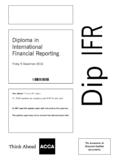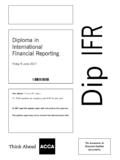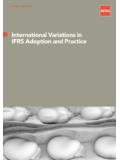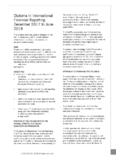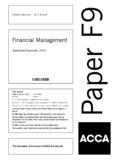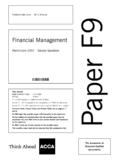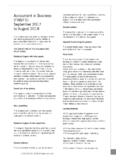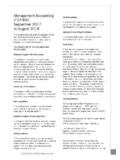Transcription of Technical Factsheet 167 - ACCA Global
1 Technical Factsheet 167 valuing trading companies CONTENTS 1. Introduction 1 2. Earnings based approaches and multiples 1 3. DCF approaches 5 4. Assets based approaches 6 5. Normalisation of earnings 6 6. Minority interests 8 This Technical Factsheet is for guidance purposes only. It is not a substitute for obtaining specific legal advice. Whilst every care has been taken with the preparation of the Technical Factsheet neither ACCA nor its employees accept any responsibility for any loss occasioned by reliance on the contents. 1. INTRODUCTION This Factsheet aims to provide a summary of the issues that need to be considered when engaged in the valuation of companies of all sorts by using an earnings based approach.
2 The calculations will give an indication of the valuation which the buyer/seller may consider rather than an exact figure. Whenever an ACCA member undertakes valuation work care should be taken to ensure an appropriate engagement letter is agreed with the client. This Factsheet will look at the application of Price Earnings ("P/E") ratios, EBITDA multiples and turnover multiples, discounted cash flow ("DCF") approaches, including discount rates, terminal values and appropriate cash flows, the normalisation of earnings, how to deal with minority interests, and briefly looks at those situations where an earnings based approach is not appropriate. This is one of a series of Technical factsheets numbered 167 to 171 looking at various valuation issues.
3 For matters to consider when reporting on valuations refer to Technical Factsheet 170 section 7. 2. EARNINGS BASED APPROACHES In this section we will look at the selection and adjustment of appropriate P/E ratios and EBITDA multiples. We will conclude with a brief look at turnover multiples (although this is dealt with in greater detail in Factsheet 171 " valuing Goodwill"). P/E Ratios A price earnings ratio is simply the relationship between the post-tax earnings of a business and its capitalised value. For example, in a sale situation if a business is earnings 100,000 post-tax and is sold for 1m, then the business is said to be sold on a P/E ratio of 10. Alternatively, for a quoted company with earnings per share of and a share price of per share the company is said to be trading on a P/E ratio of 10.
4 P/E ratios are always calculated by reference to post-tax earnings, although these may well be normalised to remove one off or exceptional items, abnormal directors' remuneration and the like. P/E ratios can be historic, current or prospective. It is important not to mix these. For example, an historic P/E ratio applied to prospective earnings or vice versa. Historic P/E ratios usually refer to the last full year's reported earnings. A current P/E ratio will refer to estimated earnings likely to be achieved in the current full year of trading, and a prospective P/E ratio will refer to earnings forecast for next year or (occasionally) for years further into the future. We set out below a short example showing the earnings of a business with an accounting date of 31 March for the last full year, the current year and for two projected years with the exit P/E ratio calculated on the basis of a sale of the company during the current year for 1million.
5 Example 2009 (Historic) 2010 (Current) 2010 (Forecast 1) 2011 (Forecast 2) Post Tax Profit ( 000) 70 120 150 170 P/E Ratio There are various sources of information from which P/E ratios can be obtained. Both company specific and sector average P/E ratios can be obtained from publications such as the Financial Times ( FT ), the London Business School Risk Measurement Service ( LBS ) and the like. In addition, P/E ratios can be calculated for individual companies by looking at the current share price and the company financial information obtainable from the company website, brokers' reports or commercial databases such as Bloomberg and Thomson Reuters.
6 When looking at company specific P/E ratios (rather than sector averages) one option is to look at the source financial data to calculate the P/E ratios individually, or at least to be able to check the calculations provided by organisations such as LBS or the FT. In addition, when looking at individual company P/E ratios it is worth checking that there is a sufficient volume of trading in order to give a reliable result. Companies trading on AIM or other smaller markets may not have a large enough volume of trades for a P/E ratio to be reliably calculated. In the same vein, P/E ratios can be distorted if there are rumours within the market that a particular company may be either the target for an acquirer or in some form of difficulty (perhaps because key personnel are leaving).
7 Sector P/E ratios can be found daily in the Financial Times Actuaries Share Indices, which provides market capitalisation weighted averages for a number of broad sectors. It should be born in mind that, particularly in smaller sectors with fewer companies, the very largest companies within the sector will have a considerable impact on the weighted average, which may well distort this statistic. The LBS provides a calculation of the sector average P/E ratios on the basis of both a weighted and a non-weighted average, and this can be a useful extra resource. In addition, the LBS also provides a more detailed breakdown of the principal sectors into smaller sub-sectors which can also be useful in allowing the valuer to focus in on a more detailed and appropriate sector.
8 Finally, P/E ratios may be derived from actual deals. These are called "exit" P/E ratios. They have within them a premium for control, and therefore no further adjustment is necessary in this regard (see below). However, it may well be that the deal price agreed contains a considerable degree of synergistic or other benefit that relates directly to the identity of the purchaser, or has taken place in a distress situation, and may not therefore be appropriate to be applied unadjusted in, for example, a tax valuation where the parties are anonymous (see Factsheet 170 for more detailed advice in this regard). Exit P/E ratios can be obtained from proprietary databases such as Bloomberg and Thomson Reuters, publications such as Acquisitions Monthly and, in much broader terms sector analysis , for example the Private Company Price Index ( PCPI ) provided by BDO Stoy Hayward, which produces a quarterly average of exit P/E ratios, further details of which can be found at Exit P/E ratios in general and the PCPI index in particular, need particular care in their application for general valuation purposes.
9 The valuer should note that the PCPI was designed only as a broad rule of thumb in estimating the discount necessary from a quoted sector P/E ratio so that ratio can be applied to any specific company in the sector. The information shown on each of the quarterly reports should therefore be read in full, and even then this ratio is perhaps best used only as a sanity check or other form of broad cross-check on an opinion derived by other means. Adjusting P/E Ratios Quoted sector P/E ratios are derived from very small trades (typically of holdings of much less than 1%) in very large quoted entities. Some of the main issues relating to adjusting P/E ratios are discussed below. We summarise below those issues which are most commonly found: Quoted sector trades are for small, uninfluential minority interests - it is not therefore appropriate to adjust the quoted sector P/E ratio downwards to reflect the size of the interest that the valuer may be asked to consider.
10 This is perhaps the single most common mistake made in adjusting quoted sector P/E ratios. An adjustment in respect of a minority interest is only appropriate if the P/E ratio being used is an exit P/E ratio. Holdings of more than 10% - it may be appropriate to add a small premium to the quoted sector P/E ratio to reflect the greater size of interest under consideration. If a controlling interest is to be valued then a control premium will be appropriate see below. Quoted companies are usually larger and are more diverse - a material discount is usually required to reflect the small size and lack of diversity of a private company compared with its quoted comparables. The actual size of the discount will depend on the facts of the case.

